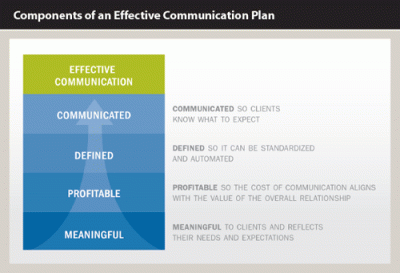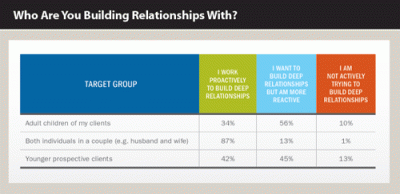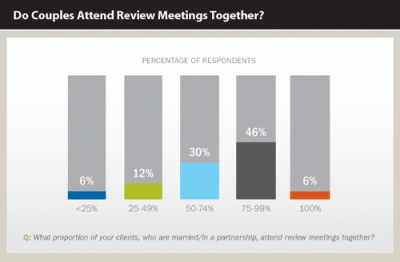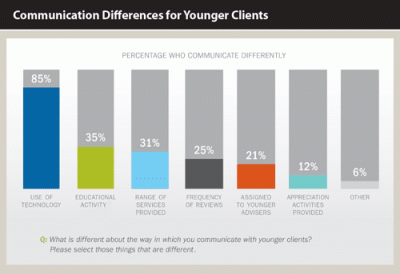Journal of Financial Planning; November 2014
You promise prospects and clients your best. The more they like what they hear, the bigger your business grows and the harder it is to deliver on that original promise. Business success breeds its own set of challenges. For many financial advisers, increased business success creates an uncomfortable gap between their commitment to clients and what those clients actually experience.
The good news is that clients are generally very satisfied with the client experience.1 The question is—are you aiming for “satisfaction” or something more? If the average client rates his or her adviser a 4.5 out of 5, then creating satisfaction may make you just as good as most other advisers. Perhaps we should be asking how we can create a client experience that is profoundly engaging, because the reality is good just isn’t good enough.
Earlier this year, the FPA Research and Practice InstituteTM (RPI) gathered in-depth data from more than 400 advisers as part of the 2014 Trends in Client Communication Study. Participants were drawn from across the country, across channels, and included both FPA members and non-members. Their input painted a comprehensive picture of how advisers are communicating today and where they see challenges going forward. If we marry those findings with data from Advisor Impact’s ongoing investor research, we can begin to paint a picture of the future of client communications as part of a process that drives deeper engagement and creates true differentiation.
Advisor Impact’s Rules of Engagement study provides a model of client engagement that suggests that the path from satisfaction to engagement is about laying a strong service foundation, crafting a meaningful offer, and playing an active leadership role in the lives of clients. These three aspects of the client experience reflect increasing levels of personalization of the client experience.
The model suggests that in order to create an engaged and differentiated client experience, we need to get the foundation right first, then build a proactive, personalized, and meaningful plan around the needs and objectives of clients. To that end, we’ll examine two key concepts in this article:
- Building a solid foundation. What defines a strong baseline level of service and what are advisers doing today to deliver it?
- Co-creating the client experience. How is the client communication process evolving to create an engaged client experience that supports a leadership role?

Building a Solid Foundation
Great service is a necessary but not sufficient condition of an engaged client relationship. Get it right, and you have a foundation on which to build. Get it wrong, and your clients will react swiftly and negatively. There are four components of an effective communication plan—it is meaningful, profitable, defined, and communicated.
Make it meaningful. A majority of advisers say they gather client feedback that will inform the client experience. Sixty-eight percent of advisers say they gather feedback from clients in some form, with informal feedback as the primary method. As it relates to using that information to personalize communications, nearly one quarter (22 percent) of advisers say they always personalize communications based on the individual interests of clients; another 62 percent say they sometimes personalize communications.
Tip: Aim to understand what is important to clients (frequency of contact, education, etc.), but also their communication style. Do they like a lot of information or just a little? Do they want to meet in person or would they prefer online reviews?
Make it profitable. For most advisers, time is the single greatest cost of service delivery. The process of assessing profitability begins with segmenting clients (71 percent of advisers say that they segment their clients today), then moves to defining service by segment and, finally, analyzing the hard and soft costs of delivery.
Tip: Assign a value to your own time in order to calculate a meaningful cost of service delivery.
Define it. Fifty-six percent of advisers have formally defined service standards, which might include such things as frequency of contact or response time to clients. In firms with multiple advisers, 56 percent say the standards are consistent across all advisers; 44 percent say that defining standards is the responsibility of each adviser separately. Of those advisers who do formally define service standards, just under half (46 percent) have a process in place to track if they have effectively delivered on those standards; another 41 percent indicate they have an informal tracking process.
Tip: Avoid generalities when it comes to service. If your goal is simply to deliver “great service,” you have no way to manage expectations, assess profitability, or standardize workflow.
Communicate it. Only 30 percent of advisers surveyed indicate that they review and reinforce service standards with their clients on an ongoing basis. For another 44 percent, standards are reviewed on a one-time basis at the outset of the relationship. Only 15 percent of advisers who communicate standards use a written service agreement; the majority (81 percent) opt for a discussion of those standards.
Tip: Manage client expectations by clearly communicating service standards and reviewing those standards on an ongoing basis to reinforce value and ensure they are still appropriate for the client.
On the basis of these four components, advisers give themselves a muted performance rating on the overall effectiveness of their client communication process. They rate overall effectiveness a 3.9 out of 5, with just 26 percent rating the process as “very effective.” On a related note, 39 percent of advisers feel that their client review process is very effective, although 83 percent rate the process as somewhat or very effective. To understand more about how the client communication process can be improved, we can borrow from academic research and integrate that with the many tactical ideas shared by advisers as part of the FPA research.
Collaborate with Clients to Create Value
A critical concept in service research that is worth examining in our profession is the concept of “co-creation of value.” While traditional value research focuses on what companies (or advisers, in this case) do to create value, we are increasingly looking at clients as active partners in the process. Simply stated, in our profession, co-creation of value is the process by which adviser and client collaborate to both define and create value.
So what does this have to do with client communication? In reviewing the data from the RPI study with a specific focus on the qualitative input from advisers, I believe we are seeing elements of co-creation in the way in which advisers seek to differentiate themselves, including:
- Client input. We see the use of client feedback on service and more direct client input on meeting agendas.
- Client participation. We see the use of creative questions and technology to put the clients’ needs at the center of the conversation in a meaningful way.
- Client reach. We see a focus on engaging couples and families as part of the overall client engagement.
Although advisers are not literally co-creating the service they provide, the way in which service is delivered is clearly becoming more holistic, more interactive, and more responsive. We aren’t simply asking clients what they expect (although this is a key starting point), but building an experience that actively involves them and delivering the service in a way that is more interactive. In so doing, I believe we are beginning to see the hallmarks of more differentiated and engaged relationships.
Here are some specific examples of co-creation in action.
Gather client feedback. Earlier, I noted that 68 percent of advisers are asking for feedback either formally (27 percent) or informally (56 percent). Consider this the baseline for a co-created relationship—it invites participation, assesses performance, and can be used to effectively identify if and how client perceptions and needs are changing. The downside of traditional feedback is that it can become a one-way conversation if there is no process to follow up, integrate results, or discuss the input with individual clients.
To use client feedback effectively to co-create value, consider asking questions about what is important to clients and what they value. Clients may not be able to tell you what is missing, but an effective survey will help you identify the gaps and act as a prelude to a deeper conversation.
Focus review content. The review meeting is perhaps the most important activity in creating value for clients and the one that is experiencing the most significant transformation. According to Advisor Impact’s investor research, 37 percent of clients see the review as delivering high value, and 51 percent see it as delivering very high value. As it relates to co-creation of value, some advisers are putting a heavy emphasis on ensuring the review meeting reflects what is current and important to the client. Some tips are:
- Hold a formal strategy meeting with your team prior to a client review to gather input on what should be addressed. Create the client agenda on the basis of that meeting. This is only relevant, of course, in some business models.
- Send a worksheet in advance of the meeting to get up to date from the client’s perspective on what, if anything, has changed. Again, use this information to craft the ideal agenda.
Involve the client in setting the agenda. Increasingly, advisers are looking for ways to involve the client in setting the agenda for review meetings. Among the ideas we’ve heard:
- Send an agenda in advance of the meeting to ask if the client would like to add anything. Put a blank space at the top of the agenda to ensure those questions/issues are addressed first.
- After the agenda has been sent, call the client directly to review and discuss it. Clients may be more likely to respond in a conversation than an email.
The reality is 9 percent of advisers say they always send an agenda in advance of a meeting; 27 percent say they do so sometimes.
Moving into the actual review, we see new forms of co-creation. Rather than focusing on input on the service provided, we are seeing innovation in getting the client actively involved in the experience of planning, whether through the questions asked or the technology used. Advisers are creating a more interactive experience in which the client is actively involved.
Dig deep to understand what matters to clients. Advisers offered up great examples of the questions they are asking clients to help them open up and share their goals and dreams. In so doing, they are more actively involving the client in the planning process. Among the questions asked were:
- You are retired. It is 10:30 a.m. on a Wednesday. What are you doing all day?
- If I ask you to think about retirement, what are three things that pop into your head?
- If I gave you all the money you’d ever need to live your life and I only required you to get up every day and do something that totally excites you, or fills your tank, but you didn’t have to do it for the money, what would that be?
- If I had a magic wand, what are the three biggest financial problems I would solve for you?
- What are your intentions for this money? Milk and eggs, tattoos and Harleys, or is this legacy money for your kids?
- If money weren’t an issue, how would you live your life?
- In your ideal course for life, are you in the center of the lane, veering off the road, in the ditch, or going the wrong direction?
- Tell me about your best financial decision and the one you most regret.
- Five or 10 years from now, what things would you like to have crossed off your list that would make you feel like you’ve accomplished something?
- What are some of the things you have wanted to do but have not been able to so far in your life?
- What do you want to be remembered for after you are gone? What do you want your legacy to be?
- What is your biggest fear about money?
- What was money like growing up?
- What’s the question you wish I would ask?
Make it interactive, literally. Technology has opened up entirely new ways to involve the client in co-creating their plan and the overall experience. Advisers shared ideas on how they are working with clients to bring the process to life during the meeting, much of which focused on making the discussion interactive and visual, and playing out scenarios together rather than following up with a written report. Among the ideas that advisers shared were:
- Use a 60-inch wall monitor to display everything during the conversation. Open the planning software and use Evernote on an iPad to record notes.
- Use a mindmap to create the family tree.
- Make use of Apple TV for office meetings and GoToMeeting for remote meetings.


Define Your Client
The final, and perhaps more fundamental, question when it comes to co-creation involves defining the client. With whom are you creating value? An individual client? A couple? A family? Your answer to that question will impact how to define and deliver on value and with whom you are co-creating.
From the RPI study, we know that advisers are proactively working to build relationships with couples but less so with the children of their existing clients.
Are You Creating Value for Couples?
Although 87 percent of advisers say they are working to proactively build relationships with couples and 80 percent of advisers say they encourage their clients to meet as a couple, they are clearly having difficulty getting clients to take action. Only 6 percent of advisers report that 100 percent of their clients who are married or in a partnership attend review meetings together.
Advisers may need to consider if their review meetings are built to engage both partners, or if the process is really built around one individual. Couples may choose not to meet together with their adviser for two main reasons—it may reflect the way in which they make decisions (29 percent of clients say they make all financial decisions alone), or the review is not perceived as valuable for both people. Your response depends on the scenario.
Scenario 1: A male client says that he makes the financial decisions and/or his wife/partner doesn’t need to participate.
Action: Engage the client in a conversation about his primary goals. Advisor Impact’s research suggests that men are acutely concerned that their wives/partners be taken care of if they pass away first. They are motivated to be family leaders. Link your client’s core objective to the need to include his spouse in the meeting and help him understand the importance of the spouse being comfortable with the adviser and with their overall plan.
Scenario 2: A male client tells you his partner or spouse isn’t interested in attending meetings.
Action: Reframe your meeting agenda to make it more compelling for the spouse. For example, there are very few women who will not want to be part of discussions about their family. More than half of clients say they are concerned that their children will not reach their financial goals, and 69 percent of clients between the ages of 45 and 54 say it would be valuable if their adviser could help their adult children create a sound financial plan now.
Consider adding the following to the agenda: (1) Ideas to help your children define and reach their financial goals; (2) Creating a plan to involve your children in the financial planning process; and (3) Resources designed to help young investors establish a solid foundation for their future.
Are You Creating Value for Younger Clients?
Today, advisers estimate that 19 percent of their clients are under the age of 40. The number is slightly higher for advisers who are under age 40 (22 percent), compared to advisers who are 60 or older (15 percent). That said, a minority of advisers (42 percent) are proactively trying to attract younger prospects and even fewer (34 percent) are proactively working to build relationships with the children of existing clients.

Advisers are split on the need to communicate differently with younger clients. Fifty-one percent of advisers say they communicate differently with clients who are under age 40. For those who see communication as different, they focus on technology. In general, there did not appear to be as much focus on crafting an offer that would attract younger clients. Perhaps we need to focus more in this area.
Social Media: A Form of Co-Creation?
The RPI study also took a high-level look at the use of social media. In addition to asking which tools were being used by advisers, the study examined if advisers were using the tools primarily to gather information or to share ideas. Fifty percent of advisers use social media to find insights on improving their businesses, and 44 percent use it to improve technical skills. Going forward, advisers indicate they will use social media less for gathering insights and more for pushing out their own ideas. Thirty-two percent of advisers say they use social media to share their own thoughts and ideas with both clients and prospects today, increasing to 43 percent in the next three years.
It strikes me that the use of social media to connect with clients in order to understand what is important to them will play an increasingly important role in co-creation of value, because it is another important way to understand the needs, interests, and preferences of our best clients. The jury is still out.
Overall, we can take comfort in the fact that clients are satisfied with their experience today. At the same time, we need to take a hard look at the future and ask ourselves if that is enough.
Those advisers who are embracing engagement as one of their key goals have a growing arsenal of tactics at their disposal to create an experience that is meaningful and differentiated. It’s not that things are changing, but that they have changed. As a profession, we might just need a nudge to recognize that fact.
Endnotes
- Investor data is drawn from Rules of Engagement, Advisor Impact/AssetMark, 2014. Adviser data is drawn from the RPI 2014 Trends in Client Communication Study, available at www.OneFPA.org.
Julie Littlechild is president of Advisor Impact, providing research and client feedback solutions for advisers. She writes a blog at www.julielittlechild.com. Email author HERE.